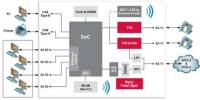An X-ray, CT scan, or MRI will be performed as soon as possible after a fall, on-field collision, or other severe injury to see if anything has been internally injured.
The fundamental threat to the health of the steel framework in the country’s aging physical infrastructure, corrosion, is being detected by researchers at the National Institute of Standards and Technology (NIST) utilizing a similar principle but in a more potent form.
They have created a non-invasive “spectral fingerprint” technology that can detect corrosion in steel that is enclosed in concrete before it seriously affects the structure it supports. In a recent work published in the journal Applied Magnetic Resonance, the detection technique is presented.
Goethite and hematite are the two most frequent iron oxide compounds that are created when water and oxygen erode iron.
“The brown rust that forms when you leave a hammer out in the rain is mostly goethite, and when a steel reinforcing bar rebar corrodes inside a concrete bridge deck, that is mostly hematite,” said NIST physical chemist Dave Plusquellic.
“We have shown in our new study with goethite, and our previous work with hematite, that terahertz radiation electromagnetic waves with frequencies 10 to 100 times higher than the microwaves used to cook food can detect both corrosion products in the early stages of formation.”
By recording changes in the physical state of the damaged steel, such as alterations in the rebar’s thickness within the concrete of a bridge or other structure, current imaging techniques for detecting corrosion use microwaves.
“Unfortunately, by the time such changes are detectable, the corrosive process is already well on its way toward causing cracks in the concrete,” said physicist and NIST Fellow Ed Garboczi.
Using a millimeter wave detector, we discovered that this antiferromagnetic absorption only occurs within narrow frequency ranges in the terahertz region of the electromagnetic spectrum yielding ‘spectral fingerprints’ unique to goethite and hematite, and in turn, iron corrosion.
Dave Plusquellic
Additionally, Garboczi said most of the microwave imaging methods rely on comparisons with baseline measurements of the steel taken at the time of construction, a practice that only goes back about 25 years.
“That’s a real problem since the average age of the 400,000 steel-reinforced concrete bridges in the United States is 50 years and there is no baseline data available for many of them,” he explained.
The NIST terahertz wave detection method works because goethite and hematite are antiferromagnetic.
In other words, the iron atoms in these materials have pairs of electrons sitting side by side that spin in opposite directions, making them insensitive to magnetic fields outside of the material. The ferromagnetic iron atoms of a household magnet, on the other hand, have electrons that spin in the same direction and are either drawn to or drawn away by external magnetic fields.
“Terahertz waves will flip the spin alignment of one of the electrons in a pair and get absorbed by hematite or goethite,” Plusquellic said.
“Using a millimeter wave detector, we discovered that this antiferromagnetic absorption only occurs within narrow frequency ranges in the terahertz region of the electromagnetic spectrum yielding ‘spectral fingerprints’ unique to goethite and hematite, and in turn, iron corrosion.”
The new NIST nondestructive evaluation technique has the potential to quickly detect minute amounts of iron-bearing oxides from early-stage corrosion of steel surrounded by concrete, polymer composites (like pipe insulation in a factory), paints, and other protective materials thanks to recent advancements in terahertz sources and detectors.
“In the laboratory, we have demonstrated that a 2-milliwatt terahertz source can produce waves that detect hematite through 25 millimeters of concrete,” Plusquellic said.
“Using terahertz sources with powers in the hundreds of milliwatts and state-of-the-art receivers with unprecedented signal-to-noise ratios, we should be able to penetrate 50 millimeters, the thickness of the concrete covering the first layer of rebar used in most steel-reinforced concrete structures.”
Next up for the NIST team will be an attempt to find a spectral fingerprint for akageneite, an iron corrosion product formed in the presence of chloride ions, which come from sources such as seawater and road deicing salt.
“Akageneite can cause problems in steel-reinforced concrete similar to those seen with goethite and hematite,” Garboczi said.
The antiferromagnetic corrosion detection method was first conceived in 2009 by the late William Egelhoff, a NIST fellow and pioneer in the field of magnetic materials.
















